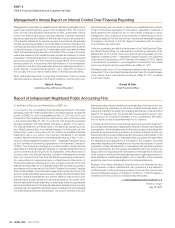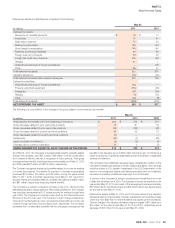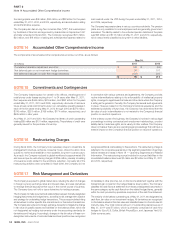Nike 2011 Annual Report Download - page 43
Download and view the complete annual report
Please find page 43 of the 2011 Nike annual report below. You can navigate through the pages in the report by either clicking on the pages listed below, or by using the keyword search tool below to find specific information within the annual report.
43NIKE,INC.-Form10-K
PARTII
Note3Property, Plant and Equipment
Management Estimates
The preparation of fi nancial statements in conformity with generally accepted
accounting principles requires management to make estimates, including
estimates relating to assumptions that affect the reported amounts of assets
and liabilities and disclosure of contingent assets and liabilities at the date of
fi nancial statements and the reported amounts of revenues and expenses
during the reporting period. Actual results could differ from these estimates.
Recently Adopted Accounting Standards
In January2010, the Financial Accounting Standards Board (“FASB”) issued
guidance to amend the disclosure requirements related to recurring and
nonrecurring fair value measurements. The guidance requires additional
disclosures about the different classes of assets and liabilities measured at
fair value, the valuation techniques and inputs used, the activity in Level3
fair value measurements, and the transfers between Levels 1, 2, and 3 of
the fair value measurement hierarchy. This guidance became effective for the
Company beginning March1,2010, except for disclosures relating to purchases,
sales, issuances and settlements of Level3 assets and liabilities, which will
be effective for the Company beginning June1,2011. As this guidance only
requires expanded disclosures, the adoption did not and will not impact the
Company’s consolidated fi nancial position or results of operations.
In June2009, the FASB issued a new accounting standard that revised the
guidance for the consolidation of variable interest entities (“VIE”). This new
guidance requires a qualitative approach to identifying a controlling fi nancial
interest in a VIE, and requires an ongoing assessment of whether an entity is a
VIE and whether an interest in a VIE makes the holder the primary benefi ciary
of the VIE. This guidance became effective for the Company beginning
June1,2010. The adoption of this guidance did not have an impact on the
Company’s consolidated fi nancial position or results of operations.
Recently Issued Accounting Standards
In June2011, the FASB issued new guidance on the presentation of
comprehensive income. This new guidance requires the components of
net income and other comprehensive income to be either presented in
one continuous statement, referred to as the statement of comprehensive
income, or in two separate, but consecutive statements. This new guidance
eliminates the current option to report other comprehensive income and its
components in the statement of shareholders’ equity. While the new guidance
changes the presentation of comprehensive income, there are no changes to
the components that are recognized in net income or other comprehensive
income under current accounting guidance. This new guidance is effective
for the Company beginning June1,2012. As this guidance only amends the
presentation of the components of comprehensive income, the adoption
will not have an impact on the Company’s consolidated fi nancial position or
results of operations.
In April2011, the FASB issued new guidance to achieve common fair value
measurement and disclosure requirements between U.S. GAAP and International
Financial Reporting Standards. This new guidance, which is effective for the
Company beginning June1,2012, amends current U.S. GAAP fair value
measurement and disclosure guidance to include increased transparency
around valuation inputs and investment categorization. The Company does
not expect the adoption will have a material impact on its consolidated fi nancial
position or results of operations.
In October2009, the FASB issued new standards that revised the guidance
for revenue recognition with multiple deliverables. These new standards
impact the determination of when the individual deliverables included in a
multiple-element arrangement may be treated as separate units of accounting.
Additionally, these new standards modify the manner in which the transaction
consideration is allocated across the separately identifi ed deliverables by no
longer permitting the residual method of allocating arrangement consideration.
These new standards are effective for the Company beginning June1,2011.
The Company does not expect the adoption will have a material impact on
its consolidated fi nancial position or results of operations.
NOTE2 Inventories
Inventory balances of $2,715million and $2,041million at May31,2011 and 2010, respectively, were substantially all fi nished goods.
NOTE3 Property, Plant and Equipment
Property, plant and equipment included the following:
(Inmillions)
As of May31,
2011 2010
Land $ 237 $ 223
Buildings 1,124 952
Machinery and equipment 2,487 2,217
Leasehold improvements 931 821
Construction in process 127 177
4,906 4,390
Less accumulated depreciation 2,791 2,458
$ 2,115 $ 1,932
Capitalized interest was not material for theyears ended May31,2011,2010, and 2009.
























